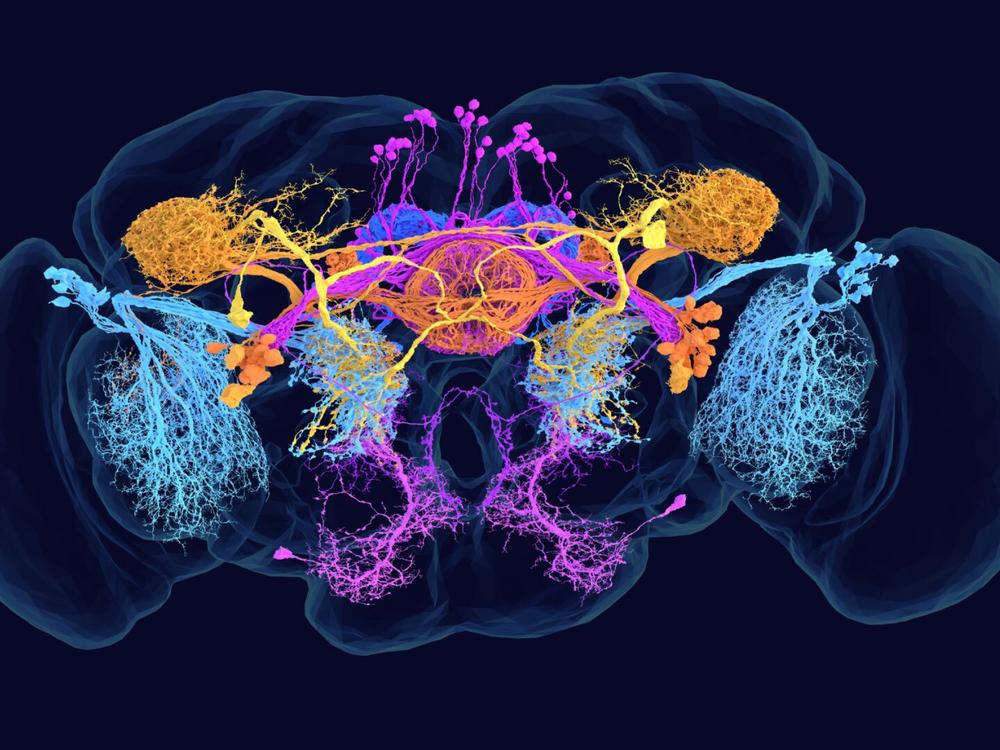Section Branding
Header Content
From fruit fly to this guy: a map of one tiny brain may show how larger ones work
Primary Content
Scientists have found 50 million reasons to study the brain of a fruit fly.
That’s how many connections they discovered in the first complete map— known as a connectome—of an adult insect’s brain.
Although a fruit fly brain is only about the size of a poppy seed, it offers insights into how all brains perceive the world, make decisions and take action, says Mala Murthy, a professor of neuroscience at Princeton University who helped lead the mapping effort.
“There’s a lot of fundamental principles of brain function that we can learn by studying the fly brain,” says Murthy, who is also co-director of the FlyWire project at Princeton.
The fly connectome also could help scientists begin to compare the brain wiring of different species, says Gerry Rubin, a senior group leader at the Howard Hughes Medical Institute’s Janelia Research Campus in Virginia who was not directly involved in the research.
“If we can understand what makes a bumblebee so much smarter than a fruit fly, that will tell us a lot about what makes a human so much smarter than a mouse,” Rubin says.
The map and related research are featured in nine papers published simultaneously in the journal Nature. These papers describe more than 8,000 cell types and look at how connections facilitate communication among brain regions.
Previously, scientists had created connectomes for the roundworm and a larval fruit fly, which have much less sophisticated brains.
A little brain that does a lot
Adult fruit flies have intrigued brain scientists for decades because the animals’ small brains are capable of complex behaviors, like flying, fighting, and even flirting.
For example, when a male fruit fly sings a love song to a potential mate, he improvises, Murthy says.
“He chooses exactly what to sing based on feedback he gets from the female fly,” she says, “and he patterns every note in accordance with her behavior.”
All that from a brain with only about 140,000 neurons. Humans, by comparison, have roughly 86 billion.
To understand how the neurons in a fruit fly do so much, you need to know how they’re connected, Murthy says.
“If you’re trying to figure out how the brain generates perceptions, thoughts, actions,” she says, “you really need to understand how information flows from sensory receptors all the way to the motor outputs of the brain.”
So Murthy and her colleague Sebastian Seung led an international team of scientists who set out to learn how a healthy brain’s wiring influences its function. Ultimately, they also hope to understand how “miswiring” leads to dysfunction in conditions ranging from epilepsy and autism, to schizophrenia and Alzheimer’s.
The fruit fly brain was an obvious place to start.
Scientists had already found all of its neurons and knew a lot about the animal’s behavior. Then in 2018 scientists at the Janelia Research Campus made public a trove of more than 20 million electron microscope images of brain areas in a single female fruit fly.
The Princeton scientists thought they could assemble those images in a way that would reveal all the wiring between neurons. They got funding from the National Institutes of Health BRAIN Initiative.
Artificial Intelligence with a human assist
The mapping process was a bit like filling in an enormous 3D coloring book, Seung says.
“If you want to trace out the wires of the brain, you’ve got to color inside the lines,” Seung says. “But that coloring book is so huge that it would take tens of thousands of years for a single person to color it all in.”
The team used computers and artificial intelligence to speed things up. Even so, the process took years, and the brain map it produced still had flaws.
“So a team of human experts, people who are trained to do this, they had to go in and correct the errors of the artificial intelligence,” Seung says.
That took more years of work by hundreds of scientists around the globe. Ultimately, though, the effort produced an accurate, annotated map of all 50 million connections in a fruit fly brain.
The research also includes a description of each neuron and information about which chemical neurotransmitters it produces. This lets scientists know things like whether a given neuron is amplifying the messages it receives or inhibiting them – information is critical to understanding both healthy brain circuits and those affected by certain brain disorders.
The new papers are an important step for the field, Rubin says. “But it’s not like we now have it and we’re done.”
Scientists still need to learn how connectomes differ from fly to fly, and how behavior is influenced by brain cells that are not neurons, and therefore not part of the connectome.
The project will truly be finished when scientists fully understand “how this little brain controls the behavior of a fly in all its wondrous navigating in space and finding a mate and fighting off competitors,” Rubin says.
Even so, researchers are already hard at work on a connectome of a mouse brain, which has about 1,000 times more neurons than the brain of a fruit fly.

